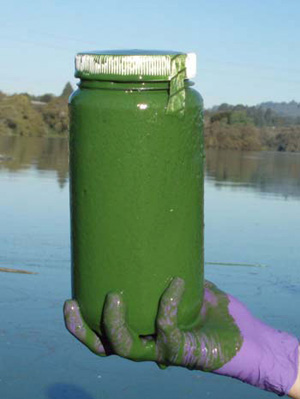A potent toxin produced by bright-green blooms of freshwater bacteria has been flowing into the ocean and poisoning sea otters, according to a team of investigators led by scientists at the California Department of Fish and Game (DFG) and the University of California, Santa Cruz.
In a paper published September 10 in PLoS ONE, the researchers reported that the deaths of at least 21 California sea otters (a federally listed threatened species) were linked to the toxin, called microcystin. First author Melissa Miller, a senior wildlife veterinarian at the DFG Marine Wildlife Veterinary Care and Research Center in Santa Cruz, will present the findings at the California and the World Ocean Conference in San Francisco on Friday, September 10.
The toxin is produced by a type of cyanobacteria (also known as "blue-green algae") called Microcystis. Warm, nutrient-rich water conditions favor large blooms of Microcystis, which can form thick green mats on the surface of the water.
"This study is significant because it is the first to establish a connection between freshwater contamination by microcystin and marine mammal mortality," said Miller, who is also affiliated with UCSC's Institute of Marine Sciences. "This land-to-sea link has important implications for marine life and human health."
Coauthor Raphael Kudela, professor of ocean sciences at UC Santa Cruz, said the team found high concentrations of microcystin in lakes bordering Monterey Bay and in rivers that flow into the bay.
"The toxin itself is extremely stable. In laboratory studies, we found that microcystin didn't degrade much even after three weeks in ocean water," Kudela said.
Microcystin poisoning can cause acute liver failure or damage other tissues and can be fatal. In 2007, Miller began seeing dead and dying sea otters recovered along the shore of Monterey Bay with evidence of acute liver failure. After tissue from the otters tested positive for microcystin, Miller teamed up with Kudela and DFG chemists to search for environmental sources of the toxin. The investigation grew to include scientists from a wide range of state and federal agencies, including the U.S. Geological Survey (USGS), the California Department of Public Health, and the State Water Resources Control Board.
Pinto Lake in Watsonville has a history of Microcystis blooms and toxin production. Testing of the lake in the fall of 2007 confirmed the occurrence of an extensive bloom with high microcystin production. Pinto Lake drains into Corralitos Creek, which flows into the Pajaro River. "We were able to track the toxin all the way down the Pajaro River to within one kilometer of Monterey Bay," Miller said.
In 2009, Kudela began monitoring Pinto Lake and other locations around Monterey Bay using a sampling tool that his lab had developed to monitor ocean water for domoic acid, a toxin produced by marine algae. During the rainy season of 2009-10, the researchers detected microcystin contamination in the freshwater outflows of three rivers flowing into Monterey Bay: the Salinas, Pajaro, and San Lorenzo Rivers. The toxin was also detected in ocean water at the Santa Cruz wharf and at the mouth of the Pajaro River in October 2009 after "first flush," the first rain event of the year.
In laboratory studies, the researchers put oysters, mussels, clams, crabs, and other marine invertebrates that sea otters like to eat into large tanks of seawater and added microcystin-contaminated Pinto Lake water to the tanks. Subsequent testing showed that digestive tissues from the shellfish had up to 107 times higher concentrations of microcystin than was in the seawater. Tissues from shellfish exposed to the toxin continued to test strongly positive for microcystin for at least two weeks after the exposures ended.
Many of the microcystin-poisoned sea otters were recovered near river mouths and harbors, Miller said. While most of the cases (17) occurred within Monterey Bay, microcystin-poisoned sea otters were also found along the Big Sur and south-central California coastlines.
Four of the poisoned otters had been previously captured and tagged with radio-tracking devices as part of long-term research (a collaboration of USGS, UCSC, DFG, and Monterey Bay Aquarium), yielding detailed information about their ranges and feeding habits. The home ranges of all four overlapped in an area near Monterey Harbor, suggesting a common source of toxin exposure in that area, Miller said. In addition, three of these otters were known to feed heavily on marine clams and mussels.
Coauthor Tim Tinker is the lead scientist on sea otter studies for the USGS Western Ecological Research Center, which recently released the results of its annual census of California's sea otter population, reporting a continued downward trend in numbers. Tinker, an adjunct professor of ecology and evolutionary biology at UC Santa Cruz, said the new findings provide one more clue in the effort to understand the observed increase in sea otter mortality.
"These findings also show the value in closely monitoring sentinel species like sea otters as a way to detect and understand threats to coastal oceans," he said.
The study suggests that humans may also be at risk from microcystin poisoning if they consume shellfish harvested near river mouths, especially during or after periods of freshwater runoff. According to Kudela, though, the toxin should not be a concern for commercially harvested shellfish, which come from areas unlikely to be contaminated by the toxin. He also noted that water treatment can remove the toxin from drinking water.
One reason for concern about human health hazards, however, is that there are no state or federal regulations for exposure to microcystin. Exposure to low levels of the toxin can damage the liver and other organs and may promote the development of liver cancer. The authors noted that no formal surveillance or regulatory system exists for microcystin detection in water or shellfish in most countries, including the United States.
The health hazards associated with recreational use of affected lakes and rivers are still unclear. Samples from Pinto Lake in 2007 yielded one of the highest concentrations of microcystin ever measured. Microcystin poisoning may also have caused the deaths of several dogs in the Monterey Bay area, Miller said.
"We suspect that dogs are getting poisoned when they drink contaminated runoff or get into the bacterial scum and then lick it off of their fur. However, we haven't been able to do perform postmortem examinations yet to confirm microcystin poisoning in local dogs," she said.
Initial project funding was provided by the State Water Resources Control Board, Division of Water Quality. The researchers have received funding from the U.S. Environmental Protection Agency to conduct further investigations at Pinto Lake and make recommendations for how the algal blooms might be controlled.
In addition to Miller, Kudela, and Tinker, the authors of the PLoS ONE paper include Abdu Mekebri and Dave Crane of the DFG Water Pollution Control Laboratory; David Jessup, Stori Oates, and Sharon Toy-Choutka of the DFG Marine Wildlife Center; Michelle Staedler and Michael Murray of the Monterey Bay Aquarium; Woutrina Miller of the UC Davis School of Veterinary Medicine; Clare Dominik and Dane Hardin of Applied Marine Sciences in Livermore; Gregg Langlois of the California Department of Public Health; and Kim Ward of the State Water Resources Control Board, Division of Water Quality.




